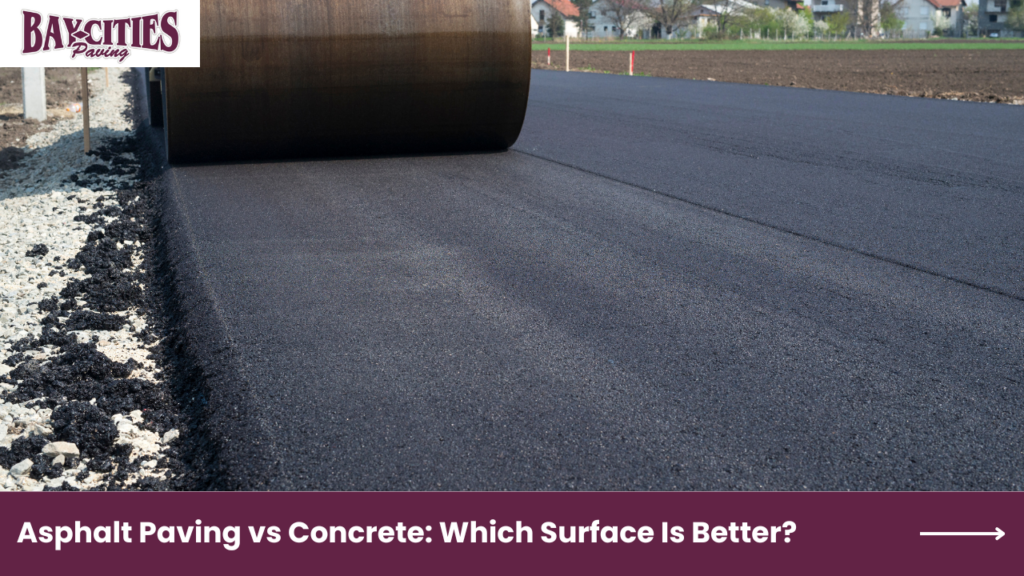When it comes to laying a new driveway, road, or parking lot, the decision between asphalt paving and concrete isn't just a matter of black or white. Each material comes with its own set of strengths and weaknesses, affecting everything from your upfront budget to long-term maintenance schedules. In this blog, we'll dive deep into the asphalt versus concrete debate, helping you understand which surface might be the best fit for your project. We'll compare these materials under various lenses such as cost, durability, climate resilience, and environmental impact. By the end, you'll have a clearer picture of how each option stacks up, guiding your choice in paving materials toward a more informed and sustainable decision.
What is Asphalt and Concrete?
Asphalt
Asphalt, also known as asphalt concrete, is primarily composed of bitumen binder and aggregates such as sand, gravel, and crushed stone. Bitumen, a petroleum-based product, acts as a glue to bind the aggregates together. Asphalt is laid down in layers and compacted to form a smooth surface. Its flexibility and black color are characteristic, aiding in heat absorption which can speed up snowmelt in colder regions.Concrete
Concrete is a mixture of Portland cement, water, and aggregates like sand and rock. Once mixed, it gradually hardens to a stone-like consistency through a chemical process known as hydration. Concrete slabs are known for their rigidity and durability, making them a popular choice for heavy-duty surfaces such as highways and industrial pavements. Unlike asphalt, concrete can be colored or textured to enhance aesthetic appeal, though it naturally ranges from light to medium gray.Comparison Factors
Cost
- Initial Installation: Generally, asphalt is cheaper to install than concrete. The cost of asphalt paving can be nearly half that of concrete, depending on local material costs. However, the price of petroleum, a key component of asphalt, can influence these costs significantly.
- Maintenance and Longevity: Concrete, while more expensive upfront, typically requires less maintenance over its lifetime compared to asphalt. Asphalt may need regular sealcoating every three to five years, while concrete does not require this treatment.
Durability and Longevity
- Asphalt: Typically lasts 15-20 years with proper maintenance, which includes filling potholes and applying sealcoat. Its flexibility allows it to withstand freezing and thawing cycles without cracking as easily as concrete.
- Concrete: Can last 30 years or more. It's less susceptible to damage from oils and gasoline but can suffer from frost heaving and is more prone to cracking if the subbase is poorly prepared.
Maintenance and Repair
- Asphalt: Easier and cheaper to repair than concrete. Potholes and cracks can often be filled and sealed relatively inexpensively.
- Concrete: Repairs are usually more noticeable and can be more complex due to the nature of the material, potentially leading to higher costs if entire sections need replacement.
Climate and Weather Resistance
- Asphalt: Absorbs more heat due to its dark color, which can help melt snow faster but contributes to the urban heat island effect. Not as durable in extreme heat as it can soften.
- Concrete: Reflects sunlight, helping to mitigate heat buildup. Performs better in hotter climates as it does not soften like asphalt. However, it can be more prone to damage from deicing salts used in winter.
Installation Time and Ease
- Asphalt: Can be laid and ready for use in a shorter period, usually within a few days after paving.
- Concrete: Takes longer to cure before it can be used; typically, a week for complete curing.
Environmental Impact
Asphalt
- Recycling: Asphalt is one of the most recycled materials, with reclaimed asphalt pavement being reused in new asphalt projects.
- Heat Absorption: Contributes to higher temperatures in urban areas.
- Permeability: Traditional asphalt is impermeable, but permeable asphalt options are available that help with drainage and reducing water runoff.
Concrete
- Carbon Footprint: Producing Portland cement, a primary ingredient in concrete, releases significant amounts of CO2. However, concrete's longevity can offset some of these emissions.
- Reflectivity: Helps reduce the urban heat island effect by reflecting more sunlight than asphalt.
- Permeable Options: Permeable concrete also exists, which can help manage stormwater more effectively than traditional concrete.
Advanced Technologies and Innovations
Asphalt Innovations
- Recycled Asphalt Pavement (RAP): Modern asphalt paving practices increasingly utilize RAP, which integrates recycled materials from old asphalt layers. This practice not only reduces waste but also lowers the demand for new petroleum products and aggregates.
- Warm Mix Asphalt Technology: This technology allows asphalt to be produced and laid at lower temperatures, reducing energy consumption and emissions of greenhouse gases during the application process.
- Bio-based Pavements: Researchers are experimenting with bio-based binders as alternatives to petroleum-based bitumen, which could significantly reduce the environmental impact of asphalt production.
Concrete Innovations
- High-Performance Concrete (HPC): Enhanced formulations that provide superior strength, durability, and longer lifespans. HPC is increasingly used in critical infrastructure and areas exposed to severe wear and environmental stresses.
- Green Concrete: Made using waste products as a partial substitute for cement, such as fly ash, slag, and recycled concrete aggregates. These materials help reduce CO2 emissions and the environmental footprint of concrete production.
- Self-Healing Concrete: Incorporates bacteria that produce limestone when activated by water ingress, effectively sealing cracks and enhancing the material's longevity and durability.
Case Studies and Practical Applications
Urban Infrastructure
- Asphalt: The city of Phoenix chose to repave its streets with a new, lighter-colored asphalt mixture designed to reflect more sunlight and reduce the urban heat island effect. This innovation not only improved comfort for residents but also extended the pavement's lifespan by reducing heat-related wear.
- Concrete: In Oslo, a major overhaul of public spaces included the use of high-performance concrete for pedestrian areas, which were subjected to heavy foot traffic and harsh winter conditions. The material was selected for its durability and minimal maintenance requirements.
Residential and Commercial Projects
- Asphalt Driveways: Many suburban homes prefer asphalt for driveways due to its cost-effectiveness and quick installation. For instance, a neighborhood in New Jersey adopted recycled asphalt for all its driveways, supporting sustainability without sacrificing quality or aesthetics.
- Concrete Patios and Sidewalks: Concrete is the material of choice for many commercial properties for sidewalks and patios due to its longevity and the minimal maintenance it requires. A shopping center in California opted for stamped and colored concrete to enhance the visual appeal while ensuring durability.
Environmental Considerations
- Permeable Pavement: Both asphalt and concrete have permeable options that are being used in environmentally sensitive areas to manage stormwater runoff. These systems help recharge local aquifers and reduce the impact of runoff on municipal storm sewer systems.
- Green Roof Parking Lots: An innovative approach in urban areas is the use of green roof technology atop concrete parking structures. These green roofs absorb rainwater, reduce heat absorption, and provide much-needed green space in urban areas.


